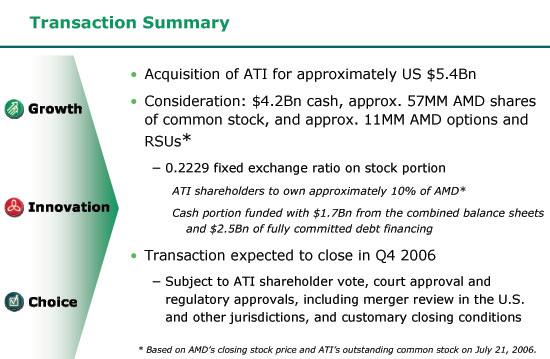AMD & ATI: The Acquisition from all Points of View
by Anand Lal Shimpi on August 1, 2006 10:26 PM EST- Posted in
- CPUs
It has now been over a week since AMD dropped the bombshell that it would be seeking to acquire ATI in a massive $5.4 billion dollar deal to be closed sometime in Q4 of this year. Regardless of each company's current position in the market, the AMD/ATI merger has the potential to completely re-write the face of competition and a number of markets we cover on a regular basis. It's a tremendous gamble on AMD's part, especially considering that much of the deal is in borrowed cash. Whether this deal ends up being the smartest move AMD ever made or the beginning of the end has yet to be seen, and honestly at this point it's far too early to predict what will come out of it should the acquisition go through.
While predicting isn't our forte to begin with, what we can do is present you all sides of the story. We'll take you through the perspectives of AMD and ATI as well as NVIDIA and Intel, and conclude with a bit of our own analysis on the entire situation. We'll start off with a bit of background information on the acquisition:
- AMD plans on acquiring ATI for a total of $5.4 billion dollars in a mixture of cash and stock. AMD will use $4.2 billion in cash ($1.7 billion currently on hand, and another $2.5 billion borrowed) and 57 million of its shares to pay for the deal.
- The deal will close in the next 100 - 120 days, finalizing it near the end of 2006.
- AMD isn't disclosing under what conditions it would walk away from the deal.
- According to AMD's Hector Ruiz, AMD is partnering with ATI to develop "integrated silicon where it makes sense".
- AMD has no intention of blocking or prohibiting the sale of ATI products to anyone, but neither AMD nor ATI is counting on things like ATI Intel chipset sales continuing going forward.
- Current ATI roadmaps over the next 6 months will remain unchanged.
- ATI's manufacturing arrangement (mainly ATI being a fabless manufacturer) will not change for the next 1 - 2 years. The current production models will remain as-is.
- AMD doesn't believe that NVIDIA will alter its relationship with AMD; NVIDIA believes the same.
- Intel has not revoked ATI's bus license and has not made any public changes to its cross-licensing agreements currently in place with AMD and ATI.

With the backdrop set, let's kick things off by looking at the merger from AMD's perspective.










61 Comments
View All Comments
johnsonx - Thursday, August 3, 2006 - link
Yep, you two are both old. Older than me. Heath H8? I didn't think selling candy bars would pay for college. You actually had to build candy bars from a kit back then? Wow. ;)Mostly the 'kids' comment was directed at your esteemed CEO, and maybe Kubicki too (who I'm well aware is with Dailytech now), and was of course 99.9% joke. Anand may be young, but he's already accomplished a lot more than many of us ever will.
Gary Key - Thursday, August 3, 2006 - link
where is the edit button... led toPrinceGaz - Wednesday, August 2, 2006 - link
Well according to ATI's investors relations webby and also Wikipedia, they were founded in 1985 and started by making integrated-graphics chips for the like of IBM's PCs, and by 1987 had started making discrete graphics-cards (the EGA Wonder and VGA Wonder).Yes, they quite obviously do predate the 3D revolution by many years. VGA graphics date from 1987 and no doubt the VGA Wonder was one of the first cards supporting it. I imagaine that EGA Wonder card they also made in 1987 would have had the 9-pin monitor connection you mention as that is the EGA standard (I've never used it but that's what the Wiki says).
All useless information today really, but a bit history is worth knowing.
johnsonx - Wednesday, August 2, 2006 - link
Yep, I stuck quite a few EGA and VGA wonder cards in 386's and 486's back then. They were great cards because they could work with any monitor. Another minor historical point: Monochrome VGA was common in those days too - better graphics ability than old Hercules Mono, but hundreds of $ less than an actual color monitor.yacoub - Wednesday, August 2, 2006 - link
Your comment should get rated up b/c you correctly state that ATI has been around for some time. Let us also not forget that NVidia bought 3dfx, 3dfx did not simply disappear. And Matrox, while mostly focused in the graphic design / CAD market with their products, has also survived their forays into the gaming market with products like the G200 and G400. Perhaps something about basing your graphics card company in Canada is the trick? :)johnsonx - Wednesday, August 2, 2006 - link
Well, 3dfx was dead. NVidia was just picking at the carcass. Matrox survives only because they make niche products for professional applications. Their 3D products (G200/G400/G450, Parhelia) were hotly anticipated at the time, but quickly fell flat (late to market, surpassed by the competition by the time they arrived, or very shortly after).mattsaccount - Wednesday, August 2, 2006 - link
>>NVIDIA also understands that dining with Intel is much like dining with the devil: the food may be great but you never know what else is cooking in the kitchen.The food in Intel's cafeteria is actually quite good :)
stevty2889 - Wednesday, August 2, 2006 - link
Not when you work nights..it really sucks then..dev0lution - Thursday, August 3, 2006 - link
But the menu changes so often you don't get bored ;)NMDante - Wednesday, August 2, 2006 - link
Night folks get shafter with cafe times.That's probably why there's so many 24 hr. fast food offerings around RR site. LOL